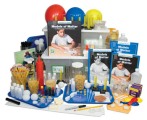Archive for October, 2013
11 Guidelines for Teaching with Discourse Circles
Discourse circles involve students in structured, evidence-based conversations around challenging statements. This article provides guidelines that can be used to conduct a discourse circle in conjunction with many science texts.
Here is a quick overview of how the discourse circle will work:
11 Guidelines for Teaching with Discourse Circles
- Select a text that provides evidence both for and against a statement. In science, good choices include books about human impact on the environment, books that mention scientific debates, and books about the history of science.
- Craft a statement for which students can find evidence to both support and contradict it. Write the statement on a Preparing for a Discourse Circle copymaster (PDF sample below) and make a copy for each student. The following are some guidelines to use when writing discourse-circle statements:
∙ The text must provide evidence both for and against the statement.
∙ The statement should not be obviously true or obviously false.
∙ Students should be able to choose either position without developing misconceptions about the topic.
∙ The statement should relate to important concepts in the text.Here are two examples of discourse-circle statements:
Students like us can help prevent oil from spilling in the ocean.
The stomach is the most important organ in the digestive system. - Make a class chart titled “Discourse-Circle Directions” that lists the directions for a discourse circle. (See the box above.) (more…)




